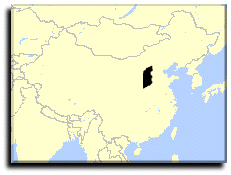The Land Of China -- Explore by Province
Shanxi
Shanxi, meaning "West Mountains", lies in the west of North China, covering an area of 156,300 square kilometers, and has a continental monsoon climate. Its population is 30,452,100 and includes ethnic groups such as the Han, Muslim, Mongolian, and Manchurian. Shanxi contains 11 cities and 118 counties with its capital set in Taiyuan City. The province is one of China's major energy bases with its rich coal and iron deposits.
 Shanxi
Shanxi
|
Having 35 key historical relics under nationwide protection and 284 under provincial protection, the province of Shanxi can be called the Ancient Chinese Artistic Museum. National key scenic areas in this province include the Wutai Mountain, the Heng Mountain, and the Waterfalls at Hukou along the Yellow River. Its famous Chinese historical and cultural cities include Datong City, Pingyao City, Xinjiang City, Dai County, and Qi County. The Jin Ancestral Hall, the Huayan Temple, the Yongle Palace, the Xuankong Temple, ancient pagodas, and grottoes - especially the Yungang Grottoes - are also very famous.
 the Yungang Grottoes
the Yungang Grottoes
|
China has four famous ancient grottoes which house Buddhist sculptures and carvings. The Yungang Grottoes is one of them and is located at the southern foot of the Wuzhou Mountain, 10 kilometers west of Datong city. The first grottoes were created in 453 A.D. and later extended to one full kilometer in length. Still extant today are 53 caves which house over 51,000 stone carvings. The largest Buddha statue is over 17 meters tall while the smallest one is only a few centimeters. All of the statues are delicate in sculpture and vivid and true to life, differing with each other in postures and facial expressions. It is the art and grandeur of the whole scene that makes Yungang so famous. The costumes and crowns, architectural designs, musical and dance performance episodes, and decorative patterns retained in the grottoes provide rich and valuable subjects for the study of the ancient Chinese culture and art.
 Wutai Mountain
Wutai Mountain
|
The Wutai Mountain has been venerated by Buddhists as one of China's four sacred sites since ancient times. Situated 230 kilometers from the provincial capital of Taiyuan in northern Shanxi, it consists of five towering peaks. Yedou, one of its peaks, is 3,058 meters above the sea level and is known as the "Roof of North China". With tall trees all over, it is a nice tourist summer resort. Inside the Taihuai Town, which is engulfed by Mount Wutai, are 47 splendid temples, including Foguang Temple, built between 471 and 499; Nanchan Temple, rebuilt in 782; Xiantong Temple, built between 58 and 75 A.D.; Luozhou Temple; and Pusading Temple. There is also a galaxy of Buddhist relics that represent both the Green and Yellow Sects in harmonious coexistence.
 the Yingxian Pagoda
the Yingxian Pagoda
|
The Yingxian Wooden Pagoda was built in 1056 and is the World's oldest and tallest wooden Buddhist Pagoda. Located in Yingxian County, the pagoda stands 66.6 meters tall with a 30-meter diameter and weighs over 300 tons. Made up of at least 3,500 cubic metres of wood, the pagoda is octagonal in shape and contains nine floors. Built without the use of nails, the entire structure is solid, imposing, and elegant. It has weathered over 900 years of wind and storm, yet has remained intact despite many strong earthquakes. It is indeed a masterpiece of ancient Chinese architecture.
 the Modair Pagoda
the Modair Pagoda
|
The Modair Wooden Pagoda was built during the later period of the Northern Wei Dynasty (386-534 A.D.) and is located in a canyon at the foot of the Hengshan Mountain. Hanging in mid-air, the pagoda is a rarity in terms of architecture. The existing 40-hall buildings made of wooden structures are scattered in different secluded spots. Built with mechanical principles, it stands propped up by hidden rocks and is based on flying beams with pillars and other beams in one integrated whole. Unique, difficult to access, and ingeniously built, it is as the local saying goes: "Hung by three horsetails suspended in mid-air." Inside the temple are 78 sculptured statues handed down from different dynasties.
 the Jinci Temple
the Jinci Temple
|
The Jinci Temple is located at the foot of Xuanweng Hill, 25 kilometers southwest of Taiyuan City. It is a famous Chinese architectural masterpiece in gardening with a history of over 1,400 years. With over 100 buildings, the Hall of Holy Mother, the Double Wooden Bridge of the Song Dynasty, and the Xiandian Hall of the Jin Dynasty occupy an important place in the history of ancient architecture. The beam rails and stone posts form a spectacular laced pattern. The carved dragons on the wooden pillars in front of the Hall of Holy Mother are the oldest among China's extant wood carvings. The Clay Statues of Maids from the Song Dynasty, the Ever-Gurgling Immortal Spring, and the Ageless Cypress are considered the "Three Rarities" of the Jinci Temple.
 the Twin Pagoda
the Twin Pagoda
|
The Twin Pagoda Monastery is located southeast of the railway station in Taiyuan City. It is called the Twin Pagoda because it has two 53-meter-tall sister pagodas containing 13 floors each. Built in 1608, the pagodas are made of brick and stone and are structured with exquisite brick-sculptured brackets and glazed, flying eaves. In the monastery are two lilacs and peonies handed down from the Ming Dynasty. In the corridor are steles with inscriptions by ancient Chinese calligraphers of great popularity such as Wang Xizhi, Yan Zhenqing, Liu Gongquan, and Su Dongpo. The Twin Pagodas have become the symbol of Taiyuan, the capital of Shanxi.















 Chinese Culture
Chinese Culture